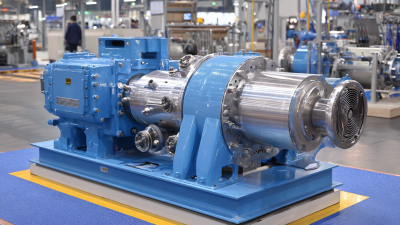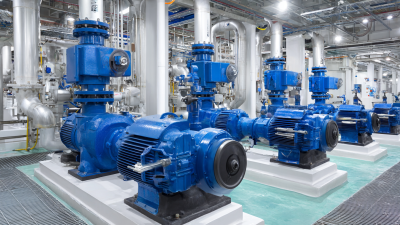Sealless Pumps for a Safer and Greener World


High pressure is a fundamental component of various scientific and practical aspects of our daily lives, influencing everything from weather patterns to engineering applications. According to a report by the World Meteorological Organization, high pressure systems often bring stable weather conditions, yet the same mechanisms can cause extreme events such as heatwaves and droughts.

Additionally, the American Society of Mechanical Engineers highlights that understanding high pressure in fluid dynamics is crucial for the design of safe structures and efficient machinery. This complexity of high pressure phenomena prompts a deeper investigation into its implications in both natural and artificial contexts, allowing us to better comprehend its effects on our environment, health, and technology.
Through this guide, we will explore the science behind high pressure and its various impacts on our everyday lives.
Atmospheric pressure plays a crucial role in shaping weather patterns and significantly influences our daily lives. It is the force exerted by the weight of the air above us, and variations in this pressure can lead to diverse meteorological phenomena.
For instance, high-pressure systems are generally associated with clear, sunny days, while low-pressure systems often lead to cloud formation and precipitation. Understanding these dynamics can help individuals make informed decisions about outdoor activities and preparations for severe weather.
Key statistics highlight the substantial impact of atmospheric pressure changes on weather forecasting and climate studies. For example, most weather forecasting models rely on barometric pressure readings to predict storms, temperature shifts, and other significant weather events. Additionally, regions impacted by consistent high or low pressure can exhibit unique climate characteristics over time, affecting agriculture, ecosystems, and even daily human behavior. By examining these patterns, we can gain deeper insights into how the invisible forces of atmospheric pressure shape the world around us.
High pressure environments can significantly influence human health, linking to various physiological and psychological responses. According to the World Health Organization, approximately 1.13 billion people worldwide suffer from hypertension, which can be exacerbated by high-pressure inducement, such as stress from work-related demands or environmental factors. This persistent elevation in blood pressure may lead to serious health complications, including cardiovascular diseases, kidney failures, and stroke—highlighting the need for awareness and mitigation strategies.
To combat the adverse effects of high pressure, individuals can employ several practical strategies. Engaging in regular physical activity—deemed essential by the American Heart Association—can help lower blood pressure and improve overall heart health. Additionally, mindfulness and relaxation techniques, such as meditation and yoga, have been shown in studies published in the Journal of Clinical Psychology to reduce stress levels significantly. These methods not only aid in managing high pressure but also foster a balanced lifestyle, allowing individuals to navigate the challenges of both external and internal pressures more effectively.
High pressure environments in sports can significantly impact an athlete’s performance. These situations often demand peak physical and mental capabilities, making it essential for athletes to comprehend how to manage pressure effectively.

Performance metrics, such as heart rate variability and oxygen consumption, play a crucial role in understanding an athlete's response to high-pressure scenarios. By monitoring these metrics during training, athletes can adapt their strategies to enhance endurance and resilience when faced with stressful competitive conditions.
Training under simulated high-pressure situations can also be beneficial. Athletes can incorporate techniques such as visualization and controlled exposure to stressful scenarios in their practice sessions. This prepares them not only physically but psychologically, allowing for better focus and decision-making during actual competitions.
Moreover, employing mindfulness and stress-reduction practices, like meditation and breathing exercises, can further improve an athlete's ability to maintain composure and perform at their best, even when the stakes are at their highest.
High pressure systems are a crucial aspect of aviation safety, influencing flight operations and passenger safety. According to the National Oceanic and Atmospheric Administration (NOAA), these systems can lead to clear skies and stable air conditions, but they also come with hazards like unexpected turbulence. A study conducted by the Federal Aviation Administration (FAA) revealed that approximately 70% of turbulence-related incidents can be attributed to high pressure systems. Pilots must be vigilant during pre-flight assessments, utilizing data from meteorological reports to anticipate potential challenges.
Tips for Pilots: Always check for high-pressure warnings in your pre-flight weather briefing. Understanding the stability of air masses can help you prepare for turbulence, which is essential for maintaining passenger comfort and flight safety. Consider using technology that provides live updates on weather conditions during the flight.
Additionally, high pressure systems can significantly impact aircraft performance during takeoff and landing. Research from the International Civil Aviation Organization (ICAO) indicates that at higher altitudes, the density of the air decreases, which can lead to longer takeoff distances. Pilots should adjust their performance calculations accordingly. Awareness of current high pressure zones is key to optimizing fuel efficiency and ensuring smooth operations.
Tips for Ground Crews: Always monitor weather reports for high pressure developments. Understanding the effects of these systems on aircraft performance can assist in preparing the aircraft properly for operations, ensuring adherence to safety protocols.
High pressure plays a crucial role in various industrial applications, from petrochemical processes to advanced manufacturing. Efficient high pressure systems can enhance productivity and reduce operational costs. Recent advancements in machine learning have led to improved performance monitoring and failure condition tracking in high pressure pulsation test benches. By analyzing specimen and test environment variables, industries can mitigate risks and enhance the reliability of their operations, leading to safer and more efficient practices.

Moreover, the integration of the Industrial Internet of Things (IIoT) optimizes supply chain management and operational efficiency. By connecting intelligent devices, businesses can monitor real-time data and streamline processes, ensuring better resource allocation and risk management. In the context of hydrogen production and safety, a comprehensive analysis framework has become essential to address potential hazards and develop effective safety management systems. These innovations not only improve industrial efficiency but also foster a culture of safety, further solidifying the importance of high pressure applications in everyday industrial life.



